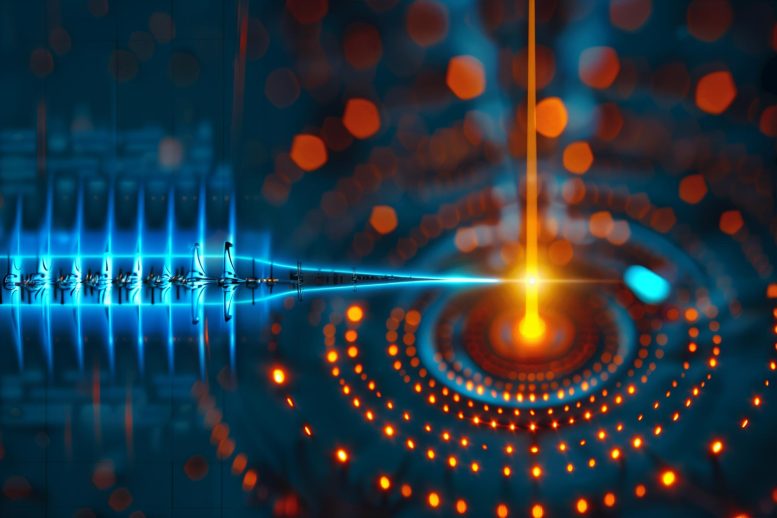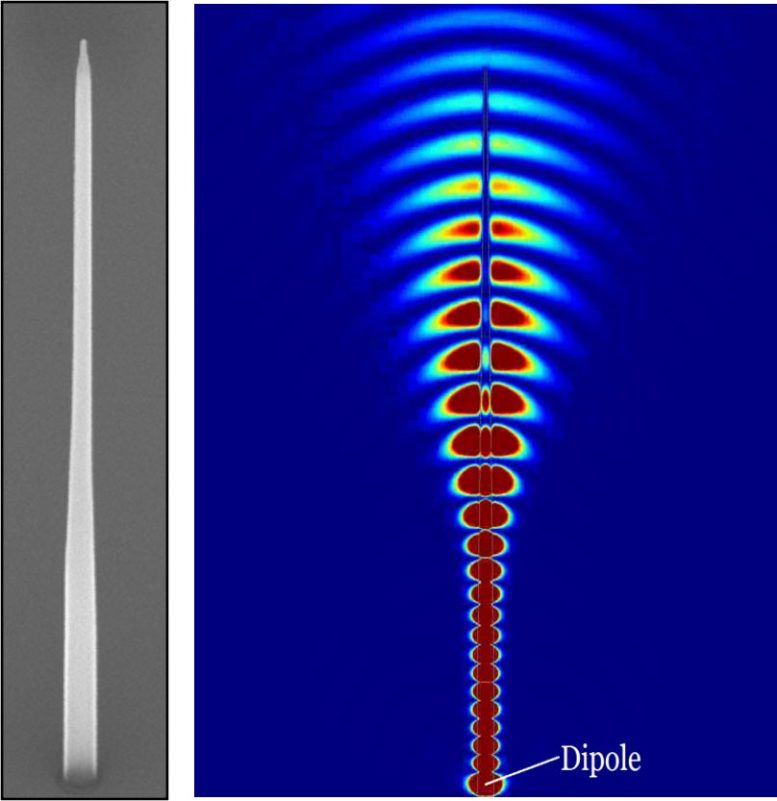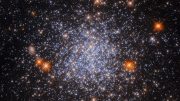
Waterloo researchers merge Nobel-prize winning physics and chemistry to enhance quantum communication efficiency and security. Credit: SciTechDaily.com
University of Waterloo researchers combine Nobel prize-winning concepts to achieve scientific breakthrough.
Researchers at the University of Waterloo’s Institute for Quantum Computing (IQC) have brought together two Nobel prize-winning research concepts to advance the field of quantum communication.
Scientists can now efficiently produce nearly perfect entangled photon pairs from quantum dot sources.
Entangled photons are particles of light that remain connected, even across large distances, and the 2022 Nobel Prize in Physics recognized experiments on this topic. Combining entanglement with quantum dots, a technology recognized with the Nobel Prize in Chemistry in 2023, the IQC research team aimed to optimize the process for creating entangled photons, which have a wide variety of applications, including secure communications.
Enhancing Quantum Efficiency and Entanglement
“The combination of a high degree of entanglement and high efficiency is needed for exciting applications such as quantum key distribution or quantum repeaters, which are envisioned to extend the distance of secure quantum communication to a global scale or link remote quantum computers,” said Dr. Michael Reimer, professor at IQC and Waterloo’s Department of Electrical and Computer Engineering. “Previous experiments only measured either near-perfect entanglement or high efficiency, but we’re the first to achieve both requirements with a quantum dot.”

The entangled photon source, an indium-based quantum dot embedded in a semiconductor nanowire (left), and a visualization of how the entangled photons are efficiently extracted from the nanowire. Credit: University of Waterloo
By embedding semiconductor quantum dots into a nanowire, the researchers created a source that creates near-perfect entangled photons 65 times more efficiently than previous work. This new source, developed in collaboration with the National Research Council of Canada in Ottawa, can be excited with lasers to generate entangled pairs on command. The researchers then used high-resolution single photon detectors provided by Single Quantum in The Netherlands to boost the degree of entanglement.
Overcoming Historical Challenges and Future Applications
“Historically, quantum dot systems were plagued with a problem called fine structure splitting, which causes an entangled state to oscillate over time. This meant that measurements taken with a slow detection system would prevent the entanglement from being measured,” said Matteo Pennacchietti, a PhD student at IQC and Waterloo’s Department of Electrical and Computer Engineering. “We overcame this by combining our quantum dots with a very fast and precise detection system. We can basically take a timestamp of what the entangled state looks like at each point during the oscillations, and that’s where we have the perfect entanglement.”
To showcase future communications applications, Reimer and Pennacchietti worked with Dr. Norbert Lütkenhaus and Dr. Thomas Jennewein, both IQC faculty members and professors in Waterloo’s Department of Physics and Astronomy, and their teams. Using their new quantum dot entanglement source, the researchers simulated a secure communications method known as quantum key distribution, proving that the quantum dot source holds significant promise in the future of secure quantum communications.
This research, “Oscillating photonic Bell state from a semiconductor quantum dot for quantum key distribution,” was recently published in Communications Physics by Pennacchietti, Reimer, Jennewein, Lütkenhaus, Brady Cunard, Shlok Nahar, and Sayan Gangopadhyay from IQC, alongside their collaborators Dr. Mohd Zeeshan, Dr. Philip Poole, Dr. Dan Dalacu, Dr. Andreas Fognini, Dr. Klaus Jöns, and Dr. Val Zwiller.
Reference: “Oscillating photonic Bell state from a semiconductor quantum dot for quantum key distribution” by Matteo Pennacchietti, Brady Cunard, Shlok Nahar, Mohd Zeeshan, Sayan Gangopadhyay, Philip J. Poole, Dan Dalacu, Andreas Fognini, Klaus D. Jöns, Val Zwiller, Thomas Jennewein, Norbert Lütkenhaus and Michael E. Reimer, 24 February 2024, Communications Physics.
DOI: 10.1038/s42005-024-01547-3









Please think deeply,
1. What is a quantum dot?
2. Can quantum dots be made out of nothing?
3. Can topological phase transitions be created from nothing?
4. Where do the geometric shapes in the universe come from?
5. Can geometric shapes in the universe be created from nothing?
6. Can geometric shapes in the universe be created from topological phase transitions?
and so on.
According to topological vortex gravitational field theory, vortices (matter) and antivortices (antimatter) are formed simultaneously, with the same geometric shape but opposite directions of rotation. Countless topological vortices make spacetime motion more complex via the synchronous effects of superposition, deflection, and twisting. Therefore, there is so much data coming in from the LHC, the most powerful accelerator in the world, that recording it all has never been an option.
All observable movements in the physical world are inseparable from the interaction of topological vortices, including human observational behavior itself.
The universe does not do algebra, formula or fraction. The universe is geometrythe, and is the superposition, deflection, and twisting of geometric shapes.
Today, we have already entered the era of the internet. With the help of artificial intelligence and big data, discussions on scientific knowledge have become open and transparent. However, a group of editors of so-called academic journals (such as Physical Review Letters, Nature, Science, etc.) are self-righteous and mystifying themselves. They only care about their own so-called sufficiently high priority rating, general significance, discipline, novelty, etc., and do not care about what science and pseudoscience are.
Science and pseudoscience are not determined by a publication, an organization or a person, nor by you or me, but by mathematics the final say. Physical models must be based on mathematics or mathematical models in order to be scientific, convincing, and in accordance with natural laws.
The origin of geometry lies in the concerns of everyday life. The branch of geometry (mathematics) known as topology has become a cornerstone of modern physics. Topological vortex and antivortex are two bidirectional coupled continuous chaotic systems. They exhibit parity conservation, charge conjugation, and time reversal symmetry. The synchronization effect is extremely important in their interactions. The synchronization effect of the superposition, deflection, and twisting of multiple or countless topological vortices will make spacetime motion more complex. To understand this complex world, physics should respect the authenticity of topological vortex in low dimensional spacetime, rather than simply relying on a few formulas, numbers, or imagined particles.
Spin is a natural property of topological vortices. Spin is synchronized with energy, spin is synchronized with gravitation, spin is synchronized with time, spin is synchronized with evolution. The perpetually swirling topological vortices defy traditional physics’ expectations. One physical properties of topological vortices is them to spontaneously begin to change periodically in time, even though the system does not experience corresponding periodic interference. Therefore, in the interaction of topological vortices, time is both absolute and relative,and physics often requires treating space and time at the same level.
Low-dimensional spacetime matter is the foundation of high-dimensional spacetime matter. Low-dimensional spacetime matter (such as topological vortex) can form new material structures and derive more complex physical properties via interactions and self-organization. It is extremely wrong and irresponsible to imagine low dimensional spacetime matter using high-dimensional spacetime matter,such as a cat in quantum mechanics.
Science must follow mathematical rules. For example, the Standard Model (SM) is considered to be one of the most significant achievements of physics in the 20th century. However, the magnetic moment of μ particle is larger than expected, revealed by a g-2 experiment at Fermilab, suggests that the established theory (such as SM) of fundamental particles is incomplete. Furthermore, the SM omitting gravitation, it not involved the time problem and when the particle movement starts. Mathematics is the foundation of science. Physics must respect the scientific nature of mathematics and mathematical models. The SM must be based on mathematical models in order to be scientific, convincing, and in line with natural laws.
I hope researchers are not fooled by the pseudoscientific theories of the Physical Review Letters (PRL), and hope more people dare to stand up and fight against rampant pseudoscience.
The so-called academic journals (such as Physical Review Letters, Nature, Science, etc.) firmly believe that two high-dimensional spacetime objects (such as two sets of cobalt-60) rotating in opposite directions can be transformed into two objects that mirror each other, is a typical case of pseudoscience rampant.
If researchers are really interested in Science and Physics, you can browse https://zhuanlan.zhihu.com/p/643404671 and https://zhuanlan.zhihu.com/p/595280873.
The Physical Review Letters (PRL) is the most evil, ugly, and dirty publication in the history of science. Nature and Science have been influenced by Physical Review Letters (PRL) and are even more notorious. The behavior of these pseudo-academic publications has seriously hindered the progress and development of human society in science and technology.
I am well aware that my relentless repetition can make some people unhappy, but in the fight against rampant pseudoscience, that’s all I can do.